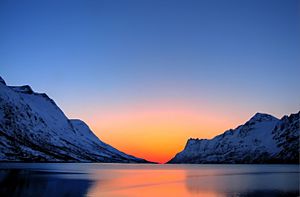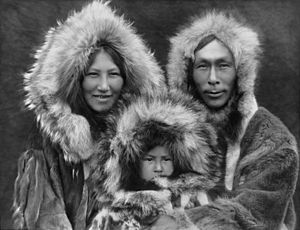Arctic ecology facts for kids
The Arctic is a super cold place at the very top of the Earth. It's everything north of the Arctic Circle. This area gets very little sunlight in winter and not much rain. Plants don't have a long time to grow because it's so cold. Arctic ecology is the study of how living things like animals and plants interact with each other and their environment in this icy region. The Arctic has special types of environments called biomes, like the taiga and tundra. Many of these natural systems are delicate and can be easily harmed. Climate change, also known as global warming, is currently causing problems for these Arctic ecosystems.
Contents
Understanding the Arctic Environment
The Arctic environment includes both land and water. Two very important parts of this environment are sea ice and permafrost.
Sea Ice
Sea ice is ice that floats in the ocean. It is made from frozen ocean water. Sea ice is important because many animals use it. They live and rest on the ice, especially during the cold winter months. Some sea ice lasts all year and never completely melts. However, there is always less ice in the summer than in the winter.
Permafrost
Lots of land in the Arctic stays frozen all year long. Permafrost is a layer of soil that has been frozen for two or more years. The dirt on top of the permafrost is called the "active layer." This top layer of dirt melts during the summer. It is very important for plants to grow in this active layer.
Arctic Food Chain
In the Arctic region, there is less food available than in warmer places. The food chain starts with tiny algae. Small insects eat these algae. Then, tiny sea creatures called plankton eat the insects. Small fish eat the plankton, and bigger fish eat the small fish. After that, seals eat the big fish. Finally, polar bears are at the top of this food chain, eating the seals.
How Living Things Adapt to Arctic Conditions
Humans in the Arctic
People living in the Arctic usually wear warm clothes and live in strong buildings. These protect them from the extreme cold. People also get used to the cold over time. This process is called Acclimatization. Most people in the Arctic live a life very connected to nature. They spend a lot of time outdoors and depend on hunting and fishing for food.
Animals in the Arctic
Animals that stay active in the winter have special ways to survive the intense cold. For example, some animals have very large feet compared to their body weight. These big feet act like snowshoes, helping them walk on snow. You can see this in animals like the snowshoe hare and caribou.
Many Arctic animals are also larger than similar animals found in warmer places. Being bigger helps them keep warm because they have less surface area compared to their body size. Layers of fat, thick fur, or feathers also act like blankets. These help animals like polar bears and marine mammals stay warm. Some animals can even digest tough, woody plants better. This is helpful in winter when other soft plants are buried under the snow.
Not all Arctic animals face the harsh winter directly. Many birds fly to warmer places when winter comes. Other animals, like some bears, go into a deep sleep called hibernation until spring. While these seem like easy solutions, they require a lot of energy and can be risky.
Plants in the Arctic
One big problem for Arctic plants is that ice crystals can form inside their cells. This can kill the plant tissue. Plants have two main ways to deal with freezing: they either avoid it or they tolerate it.
If a plant avoids freezing, it might have special ways to do so. It can grow close to the ground, where snow acts like a warm blanket. Some plants can also "supercool" their water. This means the water inside them can stay liquid even when the temperature drops far below freezing.
If a plant tolerates freezing, it allows some freezing to happen. These plants let water freeze in spaces outside their cells. This process pulls water out of the cells, making them dry. This helps the cells survive very cold temperatures without being destroyed.
Another challenge for plants in extreme cold is called cavitation. This happens when air bubbles block the tubes that carry water in the plant. Some trees have smaller water-carrying tubes. This reduces the risk of cavitation, but it also means they can't move water as quickly.
See also
 In Spanish: Ecología del Ártico para niños
In Spanish: Ecología del Ártico para niños



